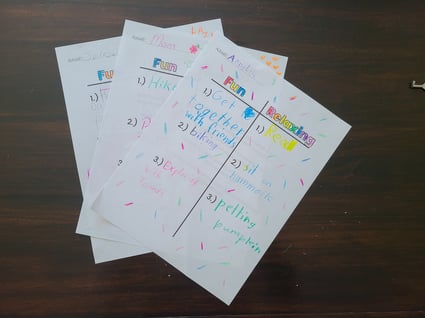Parenting with Screen Boundaries
-2.jpg)
By a Trusted Pinwheel Affiliate
Tessa Stuckey
Licensed Professional Counselor, Author & Speaker
There’s no denying that parenting today is much more difficult than previous generations before us. Parenting without today’s cultural obsession with technology is hard as it is, add in the world wide web and we have a new wave of parenting complications that is overwhelming, confusing and exhausting. However, working with teenagers and being a mother of four myself, I have found some really helpful and practical ways to build strong, resilient, independent kiddos while having technology in our home. It’s all about balance and boundaries.
The Why
As a therapist, I’ve seen it all. I have clients of all walks of life that come to my office that need help processing emotions and powering through life struggles. In the past ten years, I have had a rise of young clients, teenagers, kids and their parents, all having one big struggle that has taken over their lives and has affected their mental health: screens, screens, and more screens.
Issues such as early exposure to pornography, (the average age for a first-time viewer is now eight-years-old!) lack of motivation due to screen addiction to games and social media, familial discord due to lack of sleep, lack of the ability to regulate emotions and lack of spending quality time together, parents concerned because their child “befriended” someone online to find out it was a predator grooming their child into sending inappropriate pictures, and the darkest and worst has been the families who have lost their young child to suicide or is struggling with self- harm.
All of the needs, desires and emotions are the same for our kids that we experienced at their age, but the circumstances and cultural influences are much, much different. It’s important for us to stay aware, set up boundaries, and continue to protect our children.
The How
What exactly does it take to set those boundaries, live a balanced lifestyle and protect our kids with the best ability? I want you to start off by quickly looking around and assess your current lifestyle for your family. What are some areas that seem off balanced? It’s best to think of basic needs such as sleep and healthy diet. What about academics? Physical activity? Social skill development and time with friends or family? Are your kids on some sort of routine or is it a fly- by-the-seat-of-your-pants kind of thing? If you live a more laissez-faire lifestyle, screens will rapidly take over and monopolize everything. Screens (tablets, smartphones and video games) are much too easy to lean on, or even depend on, to fill up time. And since they have some pretty serious effects on our kids’ (and honestly, us as adults too!) mental health, it’s important to be intentional with that time and set up routines or boundaries to achieve balance.
Have your family make a list of other activities that can be done throughout the day that don’t involve screens. I like to ask my clients (and have asked my own kids) these two questions:
No matter how old your children are, they should come up with 3-5 options. This will help fill time in a different way without the screen. It will promote creativity, encourage resilience, and could even bring families together through quality time with some activities.
Print this Fun vs Relaxing family activity here!
Next up, set those time limits on devices. Because our kids’ brains are still developing and screens are so addicting, it is extremely hard and unrealistic for us to rely on them to set time limits for themselves. You can set up time limits through each device as well as through an external router (I like the Gryphon router) that your child is connected to for internet. It’s best to do both of these steps to ensure better protection. One thing I’ve learned working with teenagers is that they are some smart cookies who know how to get around a lot of parental controls, so, having a double-up system is important.
Find out more for parental controls at: www.protectyoungeyes.com
Now that your kids can only be on screens for a certain amount of time per day, they can turn towards their lists of activities for other things to fill their time. Or maybe they can turn focus to homework, house chores or time with friends. All win-win!
When it comes to social media and gaming, it is important to know what our kids are spending their time on. They may be exposed to something they are not ready to be exposed to, such as pornography, unsolicited nude photos sent by a stranger, violence, cyberbullying and more. Setting up our kid’s devices with a program to help monitor, such as Bark, is very helpful. This will help alert you when your child has been sent something or is sending something you’d rather them not.
As a mental health professional, I have seen more success with the families I work with who delay social media until their child is around 16 years old than those who allow it younger. The best outcome is to have ongoing conversations with your children even at a young age about the dangers of social media so when it is time for them to get an app, they are prepared and there is a clear plan as to how to handle it. It isn’t a matter of IF your children will be exposed, it’s WHEN.
My favorite part of my job is educating families on these matters and I am so thankful that in the past few years, tech companies have stepped up and created phones that are kid friendly, give parents peace of mind, and safe for everyone. I always suggest the Pinwheel Phone for my clients who want to introduce a phone to their child but don’t want all the negativity that comes with a smartphone. The Pinwheel phone is perfect because it already comes with all the protective gear, looks like smartphone, but is as basic as you want it for your child, so they aren’t exposed to anything too early. There is no social media, games or internet surfing. It’s a dream phone for families!
The Outcome
It makes my heart so happy when I get to see families have success with intentional tech use in their homes increasingly every day. Parenting will always be hard and challenging and while sometimes it feels that screens are helpful in this area by creating distractions, silence and quick fixes for stressful moments, it is actually adding much more hardships to your role as a parent. The inconveniences of setting screen time limits while they are still developing and growing is well worth missing out on the heartache and mental health struggles that are caused by overuse of screens.
Going out to eat and leaving the iPad or Nintendo switch behind so you can enjoy each other’s company is quite a beautiful thing for families. It takes practice, boundaries and balance to get there but it is achievable and one of the healthiest things you can do for your family’s wellbeing.
I started out my parenting journey heavily relying on Mickey Mouse playing on my phone and silly toddler games on the iPad. It was my lifeline when out in public or when I needed a minute to think. When my older two sons were about 2- and 3-years-old, I began seeing the effects of screens in my clients and decided to make a change for my family. Preventative care if you will. My twins came quickly after and there were many moments I struggled through wishing I had something to fill their boredom or keep them quiet. But I committed to a lifestyle without screen dependency and I am so glad my husband and I stuck to it. My kids are now 10, 9, 7 and 7 and it is not only no longer a struggle, but they have good behavior out in public, great imaginations and are continuing to grow behaviorally with social skills and quality time together as a family. Tech use in our house is very minimal but always intentional and productive. We use computers for work and school projects, TV for family shows and movies, and spend the rest of our time creating, playing and exploring outside.
Related Articles
Is Your Family Ready for a Phone?
By trusted Pinwheel affiliateLarissa MillsCorporate Digital & Wellness Educator, Founder of IparentGen.com
Before a family decides on a phone, it is important to think...
Kids and Teens Must Master these 3 Critical Tech Skills
PinwheelGPT: Safe and simple AI for kids
As founder of Pinwheel, I've spent years thinking about how technology impacts our children's development. When we began exploring AI for kids, one question kept coming...

-2.jpg)

